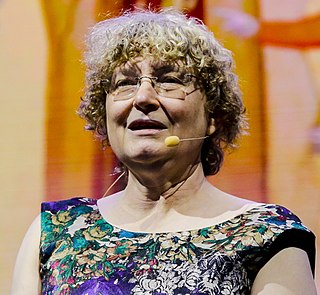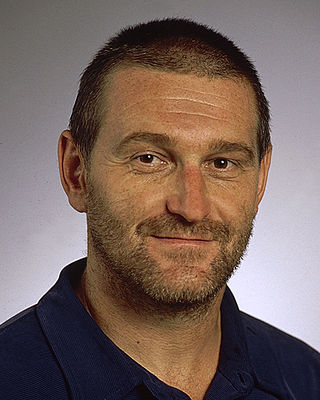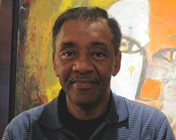Related Research Articles
Terrence Joseph Sejnowski is the Francis Crick Professor at the Salk Institute for Biological Studies where he directs the Computational Neurobiology Laboratory and is the director of the Crick-Jacobs center for theoretical and computational biology. He has performed pioneering research in neural networks and computational neuroscience.

Baroness Ingrid Daubechies is a Belgian physicist and mathematician. She is best known for her work with wavelets in image compression.

The Fannie and John Hertz Foundation is an American non-profit organization that awards fellowships to Ph.D. students in the applied physical, biological and engineering sciences. The fellowship provides $250,000 of support over five years. The goal is for Fellows to be financially independent and free from traditional restrictions of their academic departments in order to promote innovation in collaboration with leading professors in the field. Through a rigorous application and interview process, the Hertz Foundation seeks to identify young scientists and engineers with the potential to change the world for the better and supports their research endeavors from an early stage. Fellowship recipients pledge to make their skills available to the United States in times of national emergency.
The Alan T. Waterman Award, named after Alan Tower Waterman, is the United States's highest honorary award for scientists no older than 40, or no more than 10 years past receipt of their Ph.D. It is awarded on a yearly basis by the National Science Foundation. In addition to the medal, the awardee receives a grant of $1,000,000 to be used at the institution of their choice over a period of five years for advanced scientific research.

Pramod P. Khargonekar is the Vice Chancellor for Research and Distinguished Professor of Electrical Engineering and Computer Science at the University of California, Irvine. An expert in control systems engineering, Dr. Khargonekar has served in a variety of administrative roles in academia and federal funding agencies. Most recently, he served as Assistant Director for Engineering at the National Science Foundation (2013-2016), and as Deputy Director for Technology at the Advanced Research Projects Agency – Energy. From 2001 through 2009 he was the Dean of the College of Engineering at the University of Florida.
The William O. Baker Award for Initiatives in Research, previously the NAS Award for Initiatives in Research, is awarded annually by the National Academy of Sciences "to recognize innovative young scientists and to encourage research likely to lead toward new capabilities for human benefit. The award is to be given to a citizen of the United States, preferably no older than 35 years of age. The field of presentation rotates among the physical sciences, engineering, and mathematics."
Stephen Ray Wiggins is a Cherokee-American applied mathematics researcher and distinguished educator, also of British heritage, best known for his contributions in nonlinear dynamics, chaos theory and nonlinear phenomena. His wide contributions include Lagrangian aspects of fluid dynamics and reaction dynamics in theoretical chemistry.
Stephen Z. D. Cheng is a Chinese-American polymer scientist and chemical engineer. Cheng is the R.C.Musson & Trustees Professor of Polymer Science, and was the former Dean of the College of Polymer Science & Polymer Engineering at the University of Akron.

Christopher Ray Johnson is an American computer scientist. He is a distinguished professor of computer science at the University of Utah, and founding director of the Scientific Computing and Imaging Institute (SCI). His research interests are in the areas of scientific computing and scientific visualization.

Pavel Arkadevich Pevzner is the Ronald R. Taylor Professor of Computer Science and director of the NIH Center for Computational Mass Spectrometry at University of California, San Diego. He serves on the editorial board of PLoS Computational Biology and he is a member of the Genome Institute of Singapore scientific advisory board.
Michael J. Shelley is an American applied mathematician who works on the modeling and simulation of complex systems arising in physics and biology. This has included free-boundary problems in fluids and materials science, singularity formation in partial differential equations, modeling visual perception in the primary visual cortex, dynamics of complex and active fluids, cellular biophysics, and fluid-structure interaction problems such as the flapping of flags, stream-lining in nature, and flapping flight. He is also the co-founder and co-director of the Courant Institute's Applied Mathematics Lab.

The Center for Neurotechnology (CNT) is an Engineering Research Center funded by the National Science Foundation to create devices to restore the body's capabilities for sensation and movement. The National Science Foundation has awarded the CNT $~30 million since 2011.
Chung-Chieh Jay Kuo is a Taiwanese electrical engineer and the director of the Multimedia Communications Lab as well as distinguished professor of electrical engineering and computer science at the University of Southern California. He is a specialist in multimedia signal processing, video coding, video quality assessment, machine learning and wireless communication.

Pietro Perona is an Italian-American educator and computer scientist. He is the Allan E. Puckett Professor of Electrical Engineering and Computation and Neural Systems at the California Institute of Technology and director of the National Science Foundation Engineering Research Center in Neuromorphic Systems Engineering. He is known for his research in computer vision and is the director of the Caltech Computational Vision Group.

Milton Dean Slaughter is an American theoretical and phenomenological physicist and affiliate professor of physics at Florida International University. Slaughter was a visiting associate professor of physics in the Center for Theoretical Physics, University of Maryland, College Park while on sabbatical from Los Alamos National Laboratory (LANL) of the University of California from 1984 to 1985. He is also chair emeritus and university research professor of physics emeritus at the University of New Orleans (UNO). Prior to joining UNO as chair of the physics department: He was a postdoctoral fellow in the LANL Theoretical Division Elementary Particles and Field Theory Group (T-8); LANL Theoretical Division Detonation Theory and Applications Group (T-14) staff physicist; LANL Theoretical Division affirmative action representative and staff physicist; LANL assistant theoretical division leader for administration and staff physicist (T-DO); LANL Nuclear and Particle Physics Group staff physicist—Medium Energy Physics Division (MP-4); and LANL Historically Black Colleges and Universities (HBCU) project manager (laboratory-wide).

Bruce Edward Hajek is a Professor in the Coordinated Science Laboratory, the head of the Department of Electrical and Computer Engineering, and the Leonard C. and Mary Lou Hoeft Chair in Engineering at the University of Illinois Urbana–Champaign. He does research in communication networking, auction theory, stochastic analysis, combinatorial optimization, machine learning, information theory, and bioinformatics.
Leslie Ann Kolodziejski is an American professor of electrical engineering at the Massachusetts Institute of Technology. She works on fabricating novel photonic devices after synthesizing the constituent material via molecular-beam epitaxy. She is a recipient of the Presidential Young Investigator Award from the National Science Foundation and is a fellow of The Optical Society.
References
- ↑ "Young Investigator Awards Program revised". Stanford News. Stanford University. September 27, 1991. Archived from the original on July 29, 2010. Retrieved May 23, 2023.
- ↑ "Faculty Early Career Development (CAREER) Program" (PDF). National Science Foundation . Retrieved January 1, 2016.
 This article incorporates text from this source, which is in the public domain .
This article incorporates text from this source, which is in the public domain . - ↑ Zurer, Pamela S. (1990). "Presidential Young Investigator Awards Program under Review". Chemical & Engineering News. 68 (45): 24–49. doi:10.1021/cen-v068n045.p024.
- ↑ Zurer, Pamela (1990). "NSF young investigator program may be slashed". Chemical & Engineering News. 68 (50): 7. doi:10.1021/cen-v068n050.p007.
- ↑ "Frances H. Arnold, George P. Smith and Gregory P. Winter, the 2018 Nobel laureates in chemistry". Multimedia Gallery. National Science Foundation. October 3, 2018. Retrieved May 25, 2023.
- ↑ "Alice M. Agogino – Biographical Sketch". bestatberkeley. Archived from the original on November 23, 2015. Retrieved November 22, 2015.
- ↑ "Paul Alivisatos Ph.D." NanoScienceWorks. Archived from the original on April 12, 2016. Retrieved June 9, 2016.
- ↑ "Presidential Young Investigator Award: Fault Tolerance in Parallel Processor Systems". National Science Foundation . Retrieved January 25, 2011.
- ↑ "PAUL F. BARBARA ENDOWMENT FOR STUDENT EXCELLENCE IN NANOSCIENCE". Texas Materials Institute . Retrieved September 14, 2014.
- ↑ "NSF 92-55 Directory of Awards, Engineering Directorate" . Retrieved October 24, 2022.
- ↑ "Judith A. Curry CV" (PDF). Congress. Retrieved January 23, 2020.
- ↑ "Three Purdue Professors Received Presidential Young Investigator Awards". www.purdue.edu. Retrieved October 21, 2023.
- ↑ "Rina Dechter Curriculum Vitae" (PDF). Retrieved June 18, 2015.
- ↑ "Feigon, Juli". UCLA Chemistry and Biochemistry. Retrieved January 25, 2016.
- ↑ "Presidential Young Investigator Award". NSF Award Search. Retrieved July 1, 2023.
- ↑ "NSF Award Search: Award # 8451694 - Presidential Young Investigator Award". National Science Foundation. Retrieved January 17, 2022.
- ↑ "Presidential Young Investigator Award: Rapid Numerical Algorithms for Scientific Computation". National Science Foundation . Retrieved February 19, 2011.
- ↑ "Bruce Hajek". UIUC Electrical & Computer Engineering.
- ↑ "Presidential Young Investigator Award: Basic Studies in Haptics and Tactile Perception". nsf.gov. Retrieved January 26, 2013.
- ↑ "Presidential Young Investigator Award: Semantic Analysis in Support of Parallel Computation". National Science Foundation . Retrieved May 1, 2015.
- ↑ National Science Foundation award #9057135
- ↑ "Presidential Young Investigator Certificate" . Retrieved August 23, 2020.
- ↑ "Presidential Young Investigator Award #DMR8657211" . Retrieved August 23, 2020.
- ↑ "NSF Awards" . Retrieved October 17, 2018.
- ↑ "PYI: Computer Graphics to Visualize Scientific and Medical Data". NSF Award Search. National Science Foundation . Retrieved July 1, 2023.
- ↑ "Presidential Young Investigator Award: The Chemistry of Recombination Sites at Semiconductor Interfaces". National Science Foundation.
- ↑ Miller, Michael. "Curriculum Vitae" (PDF). Center for Imaging Science, The Johns Hopkins University.
- ↑ "NSF Award Search: Award#8351364 - Presidential Young Investigator Award". www.nsf.gov. Retrieved March 29, 2016.
- ↑ "NSF Young Investigator Award". National Science Foundation . Retrieved August 24, 2020.
- ↑ "NSF Award Search: Award # 9058217 - Presidential Young Investigator Award". www.nsf.gov. Retrieved August 15, 2021.
- ↑ "NSF Award Search: Award # 9296102 - Presidential Young Investigator Award". www.nsf.gov. Retrieved August 15, 2021.
- ↑ "Presidential Young Investigator Award". National Science Foundation . Retrieved May 11, 2014.
- ↑ "NSF Presidential Young Investigator Award/Reconstruction in Thin Films" . Retrieved December 2, 2019.
- ↑ "Award Abstract # 8858228: Presidential Young Investigator Award". National Science Foundation. Retrieved May 21, 2023.
- ↑ "Presidential Young Investigator Award (Materials Research)". National Science Foundation. Retrieved August 24, 2020.
- ↑ Presidential Young Investigators 1991 Awardees
- ↑ Prof. Munther A. Dahleh
- 1 2 3 Brizius, Martine; Butler, Patricia; Frechtling, Joy; Lockwood, John; Prescott, Debra; Silverstein, Gary; Westat (July 2001). "A descriptive analysis of the Presidential Faculty Fellows Program: Contributions to science and engineering through leadership in research and teaching" (PDF). Retrieved May 23, 2023.
- ↑ "NSF Award Search: Award#9357620 - Mathematical Sciences: NSF Young Investigator". National Science Foundation . Retrieved January 8, 2018.
- ↑ "Curriculum Vitae of Lisa Randall" (PDF). Harvard University — Department of Physics. Retrieved May 23, 2023.
- ↑ "NSF Young Investigator Award". National Science Foundation . Retrieved April 12, 2017.
This article needs additional or more specific categories .(January 2021) |